Ali Darwish | Zainab Masry |Mais Chitian
Umm Tariq lives with her three children in constant suffering inside a tent that resembles “nylon bags” and that does not protect from the winter cold or the summer heat. After her husband was arrested and she could not have any information about him, she left the Syrian city of al-Qusayr and took a safe refuge in the neighboring Lebanese town of Aarsal, in the far northeast of the Bekaa governorate.
However, the recent frost wave that has recently struck Lebanon increased the suffering of the refugee family and other families living in 7,000 tents in the region, where crises are similar, including the hard living conditions, the scarcity of employment and education opportunities, and the security pressure on the residents.
Aarsal returns to the headlines every winter, due to the stories coming from the region’s camps, which are similar to the story of Umm Tariq, as well as the unheard distress calls made by the refugees, or “displaced persons” in the Lebanese term.
Unfortunately, the cold is not the only problem that the Syrians living in Aarsal, which is adjacent to the borders of their country, suffer from. It is instead part of enormous ongoing suffering for seven years, during which they have been subjected to security prosecution, arrest, and prevention from work and construction, and their children have been struggling to get a proper education.
In this file, Enab Baladi communicated with ten sources from the residents of Aarsal camps, those in charge of them, and relief as well as educational activists, to shed light on the situation of Syrians living in the region, most of whom asked not to be named for fear of “voluntary repatriation” to Syria.

Lebanese children looking from the roof of their house at the Syrian refugee camps in Aarsal – 16 June 2019 (AP)
Snow brings tragedy back to the forefront…
Syrians living in Aarsal have no heating or medical services
The water surrounds the tent of Umm Tariq from three sides, and leaks one night into it, wetting mattresses and carpets. She rushes with her older child to lift the items of the tent, and the son tries to move his little brother to the neighbor’s tent, passing through the cold water ponds that are spread in the middle of the paths between the tents and that wet his clothes to his knees. This made the child suffer from “a complex” of touching cold water, according to his mother.
Umm Tariq, 43, described the situation to Enab Baladi as “tragic,” pointing out to the absence of maintenance in the tents. She further stated that the sanitation channels in the shelters are floating around, which leads to the leakage of sewage into them, causing pollution and diseases along with the cold.
The situation is not much different for Abu Faraj, 48, who is suffering from the cold and the scarcity and high prices of foodstuffs that are needed to support his wife and eight sons and daughters, with whom he lives in a 24-square-meter tent.
Abu Faraj, a resident of Aarsal refugee camps, is an unemployed refugee due to the lack of opportunities and the employers’ exploitation of Syrian refugees, as he put it. He does not find milk for his ten-month-old baby or his four-year-old twins and demands the provision of food cards and the re-registration of Syrians living in the Aarsal camps, who had been removed from the UN relief lists.
No means of heating
The most critical needs of the residents of Aarsal refugee camps are tents, heaters, heating materials, foodstuffs, and medicines. Many shelters are torn by cold air after being frozen by snow. Besides, many families have heaters that have been broken after more than five years since they were given to them, and some families are still trying to repair and reuse them.
In addition to the heaters, these families need fuel for heating. This was confirmed by one of the volunteers of Molham Volunteering Team active in Aarsal, who said in an interview with Enab Baladi that the residents of the tents need heating first. Therefore, Molham Volunteering Team is currently working to provide fuel to the camps. After cooking, residents generally need aids, such as foodstuffs and payment of land rents, because the majority of refugees in Aarsal refugee camps are unemployed.
The Team pointed out that the Lebanese laws have not restricted the arrival of aid to the people of the camp; “On the contrary, sometimes the army’s machines help the activists in the storm and open some roads where snow accumulated.”
Some relief organizations distribute 20 liters of fuel oil for each tent in some of the camps for which they are responsible. This quantity is sufficient for three to four days as a maximum per family. The distribution in some fields reached four times from the beginning of winter till now, a total that is unfortunately still “not enough” to ward off the cold winter and wave of frosts carried by the weather in Lebanon, stated Abu Faris, a resident, and activist of Bunyan al-Qalamoun camp in Aarsal, to Enab Baladi.
Insufficient aids
Abu Faris estimated that 30 percent of the residents of Aarsal refugee camps are permanently removed from the UN lists of relief aids, pointing out that the “calamity” exists at this segment because they need a monthly average of approximately $ 400 to cover only their basic needs.
The absence of coordination between the organizations working in the relief field in Aarsal camps is one of the most important reasons that lead to the lack of equal distribution of aids to a large number of camp residents. This is because many organizations support some camps several times a year, at a time when no organization supports the other fields, which leads to an imbalance in the provided aids.
If the organizations working in Aarsal cooperate, the needs of the camps will be fully covered, as stated by the social activist in Aarsal refugee camps, Huda Buraidy, to Enab Baladi.
The need for refugees in the Aarsal camps for heating and their types of equipment is also accompanied by their need for specialized medical staff and medical supplies, especially children’s medicines, such as antipyretics, antibiotics, analgesics, and colds, throat congestion and cough medicines.
Insufficient medical points
Doctor Ahmad Khallouf, who works at the Medical Commission Hospital in Aarsal and two other health centers in the same area, said that the hospitals mostly lack medicines for hypertension, heart, chronic diseases, and prevalent infectious diseases. With the availability of these medicines in the Lebanese pharmacies, they are sold at high prices in Aarsal, forming a financial burden that the Syrian refugee cannot bear.
Khallouf pointed out in an interview with Enab Baladi to the absence of health support in the Syrian hospitals in Aarsal, as the International Red Cross organization covers 15 percent of the needs of the Medical Commission Hospital and the hospital he works in relies on “symbolic” fees that it receives from the Syrian auditors. Syrian patients pay 3,000 Lebanese Pounds ($2) as a symbolic fee for medical examination, but they later suffer when buying the prescribed medicines, due to their unavailability.
Only eight medical points are available for 100,000 people in all Aarsal. At the same time, five of them receive Syrian refugees, namely the Medical Commission Hospital, the New Aarsal dispensary, al-Rahma hospital, al-Amal Center, the Caravans dispensary, in addition to hospitals affiliated to Doctors Without Borders organization, whose work is closer to field hospitals.
According to Khallouf, the Medical Commission Hospital s Hospital in Aarsal suffers immense pressure as Syrian patients come to it from the regions of Tripoli, the Beqaa and other Lebanese areas due to its low medical costs, as it provides multiple clinics, six nurseries, dialysis center with three devices, and operating rooms for orthopedic and general surgery and obstetrics.
New Aarsal’s dispensary suffers from almost absolute lack of medication and fuel oil, which led its administration to ask fuel oil from people to warm the place and treat patients.
The pretext of “terrorists”…
How Aarsal residents got rid of it
The security grip on Syrians in Aarsal has loosened during the previous two years, compared to the period that followed the arrival of the “Free Syrian Army,” the “Jabhat al-Nusra” (Al-Nusra front) and ISIS, from their areas of control in the Qalamoun and Jarud, near the Syrian-Lebanese border, to Aarsal.
This came after the military operations launched by the Syrian regime forces, “Hezbollah” militia, and the “National Defense Forces,” along with the participation of the Lebanese army in June 2017.
The army and security forces have conducted several raids, either on the camps or their wanted militants’ houses during that period. So, it gradually returned to a “comfortable” situation, as described by Syrians, whom Enab Baladi met in the town.
The security forces previously announced the arrest of many people on charges of belonging to “terrorist” organizations, accusations that were directed at Syrians in Aarsal, especially as they are considered, by the Lebanese interior, the security forces and the army, as a center for “terrorists,” because it is located on the Syrian-Lebanese border and the control of “Al-Nusra” and ISIS on the areas adjacent to it previously.
How are security services currently communicating with Aarsal refugees?
The administration of refugee camps in Aarsal plays a significant role in the communication process between the Lebanese government, security authorities and Syrian refugees; today, if it is related to a specific camp or a particular person in one of the camps, according to the camp chiefs’ statement to Enab Baladi.
The role of the Syrian Popular Committees, Syrian activists, and camp management in communication operations appears when it goes beyond a specific camp and becomes an issue related to Syrians in general in Aarsal.
The Lebanese authorities instruct the previous authorities to order or developments and alerts about the security situation and others related to the Syrians updates, such as the instructions of the security authorities for the Syrians not to move and to be neutral toward the situation in Lebanon; following the outbreak of the demonstrations on 17 October 2019, when the Lebanese demanded the ruling political class to leave and wanted a “technocratic” government.
Furthermore, any problem between refugees and the Lebanese authorities requires communication between the bodies and activists.
The municipality, which some of the people whom Enab Baladi met in Aarsal described as “the mother of the city,” plays the role of mediator in the communication process, and the Syrian authorities consult it in case of problems (often the meeting is held with the mayor or the secretary).
For example, the municipality sponsored communication to facilitate the process between the Syrian authorities and the heads of the camps, and the officer in charge of the Lebanese army for the area, following a demolition decision of tents that their owners exceeded the construction of the inner wall of the “block” meter, in addition to demolishing concrete camps. The Lebanese authorities issued the decision in May 2019.
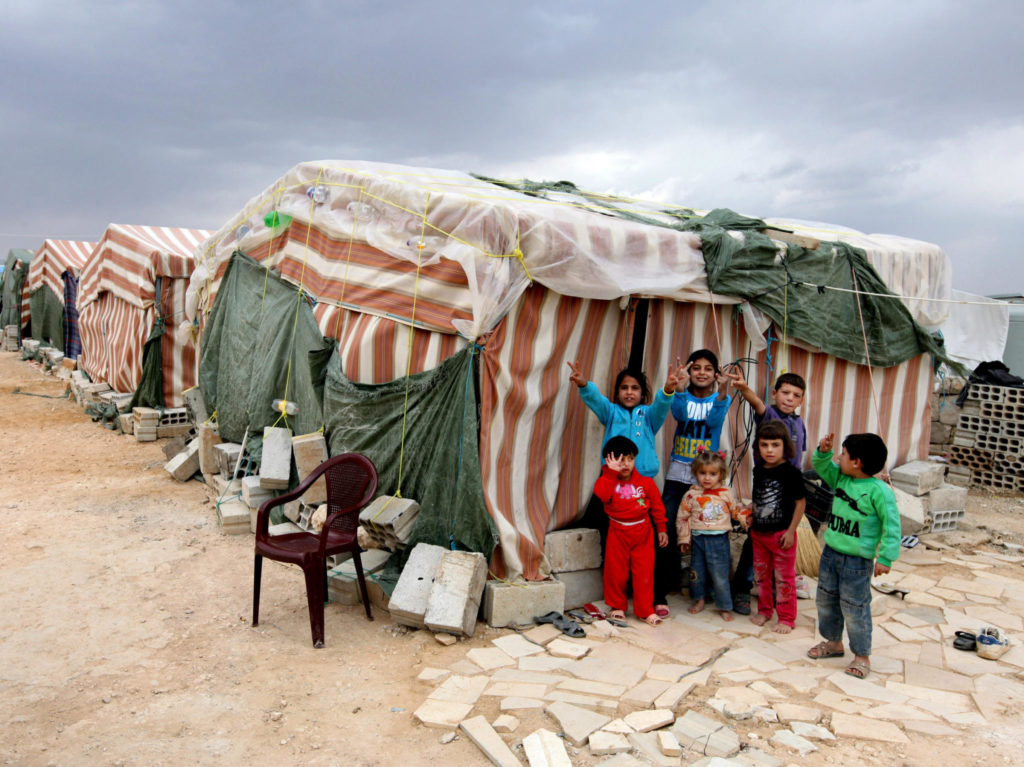
Syrian children flash victory signs 2 October as they stand in front of their tents at a refugee camp in Arsal, a Sunni Muslim town in eastern Lebanon near the Syrian border. The town has become a haven for war-weary Syrian rebels.
Expensive living and scarcity of aid…
How do Aarsal refugees secure their living?
The total number of Syrians’ camps in Aarsal is 135, and each camp includes from 50 to 100 tents. In contrast, the area consists of about 2,500 houses inhabited by Syrians, according to an official in the Coordination and Follow-up Committee for the camps in the region (who spoke on condition of anonymity).
The Committee notes that one family requires an average of $400 per month to be able to cover its necessary expenses. The percentage of displaced people who benefit from UNHCR support is around 80% of the camp population.
Jobs cannot cover the rent of a tent
Abu Ahmad, a displaced Syrian in the Aarsal camp, told Enab Baladi that his family condition is “bad.” He has been working for two years in a food store, from 6 AM until 3 PM for only $3 per day, less than $100 per month.
He lives with his wife and three children in a rented tent, for which he pays $15 a month, in addition to the costs of electricity, water, and cleaning services, about $23 monthly. The tent also needs an ampere of private power per month, which costs $12.
Abu Ahmad says that although he receives $ 125 a month from the UNHCR, ($27 for each family member), this is not enough, and he needs at least $450 to cover his family’s and children’s school expenses, which led him to borrow frequently.
He pointed to a significant increase in food prices, because he works in a food store, due to the deterioration of the Lebanese Pound value against the US Dollar, as it recorded 2,250 Pounds against the Dollar after it was previously 1,500 Pounds against $1, which affects Syrians’ purchasing power in the region.
As for heating fuel, Abu Ahmad said that the family requires 300 liters of fuel oil in the winter, which costs $150.
Specific works
The percentage of legally employed workers according to work permits out of all Syrians in Aarsal does not exceed 5%. At the same time, the Lebanese government allows refugees to work only in agriculture and construction. Syrians are prohibited from carrying out any extraordinary work, according to the official in the Coordination and Follow-up Committee.
The rest in the camp illegally engage in self-employment, such as rocks cutting, sawmills, and cladding, and the wages of a worker do not exceed $10 per day.
Some youths suffer from high unemployment due to a lack of work opportunities or because of disability. The elderly are not able to engage in strenuous and stressful work.
As for agriculture, it is a profession that is not popular in Aarsal due to its nature and the inappropriate weather, especially in the winter season. People who work in agriculture depend on greenhouses, or on cultivating land with a small area or doing work on agricultural lands, such as pruning the trees.
Demolishing concrete housing…
Pressure for “voluntary repatriation.”
In light of the Syrians’ severe economic conditions in Aarsal, the Lebanese army demolished their homes in July 2019, under the pretext of violating the terms of construction law, according to a decision issued by the Lebanese Supreme Council of Defense, in May of the same year.
The number of tents in the Aarsal camp is estimated at 15,000 tents. Seven thousand of these are made of stone walls, and about 2,500 are of concrete walls, according to an official from the health care program at the Union of Relief and Development Associations working in the region, Ziyad Aziz.
Speaking in a previous interview to Enab Baladi, Aziz said that the construction of arbitrary or “violating” camps, referring to concrete tents, came to specific matters related to the area of Aarsal specifically, in light of the absence of the state in the region for a long time, in addition to the long period of the asylum and the unavailability of any political vision that can end their crisis in Syria, so they start to return.
Extreme cold is one of the reasons that pushed the refugees to create the concrete walls of their tents in Aarsal, as they are warmer and resistant to winds, snowstorms and rainstorms more than the fabric tents, as well as closing them with doors and windows that suit the refugees’ living, according to Samer al-Masry, a volunteer in the UNHCR “The International Rescue Committee in Aarsal.”
Human Rights Watch (HRW) said that the Lebanese army demolished shelters for Syrian refugees on 1 July 2019 because it did not fit the long-standing housing laws that were “seldom enforced.”
Bill Frelick, director of Human Rights Watch’s refugee program, criticized the demolition of tents, and said, after witnessing the removal of the Syrian refugees’ shelters in Aarsal and the Bekaa Valley, “We must pay attention to the real intentions behind this campaign on violations of the housing law, which consists of exerting pressure on Syrian refugees to leave Lebanon.”
Frelick added that the demolition order is one of many other recent measures to increase pressure on Syrian refugees to return to their country, which include mass arrests, deportations, shop closures and the confiscation or destruction of unlicensed vehicles, in addition to other long-standing restrictions, including curfews and evictions, as well as preventing the refugees from having access to education, legal residency, and work permits.
While the decision to remove concrete tents is justified by “refugee settlement concerns,” Lebanese officials are increasingly voicing the need to expedite a solution for the refugee file by returning them to their country.
In 2018, the Lebanese state started taking steps to return the Syrians, through coordination between the Lebanese security apparatus, the Syrian regime and the Russian Reconciliation Center for Syria in Hmeimim. Thus, many of the most recent batches of refugees were returned in early February, while more than 900 people returned “voluntarily” in one day.
Three types of education
Future of Aarsal children is “lost” between different degrees
While there are no opportunities for university education for Syrians in Aarsal, the forms of school education for children vary with the agencies that provide it, as well as its value and impact as a result of the crisis of not recognizing the certificates obtained by most students.
Enab Baladi contacted activist Majid Barsha and the headmaster of Hayat village school in Aarsal, Nasouh Hammoud, to find out more about the condition of school education in the region, which is divided into three sections.
The first form of education is provided by the Lebanese government in four Lebanese schools, in which 3,200 Syrian students are studying. The Syrian students, who attend classes after the end of the Lebanese students’ studying hours, receive certificates issued by the Lebanese Ministry of Education, which qualifies them to enter Lebanese universities.
Associations support the second of education form. It is carried out in Syrian schools (centers) or Lebanese private schools, where the Syrian students also attend classes after the end of the Lebanese students’ studying hours. 5,990 Syrian students are distributed over 14 schools, while this number was estimated at 6,688 last year.
The Ministry of Education issues the certificates ensured by the second pattern of education in the Interim Syrian Government, which did not provide any support for the education facilities in Aarsal, except for the certificates. Even the books employed for a period of six years in these schools were replaced by others containing the Lebanese curriculum.
What are the problems of the Interim Government’s certificates?
The certificates issued by the Interim Syrian Government do not entitle their holders to complete their university education in Lebanon, which prompted some students to sit for the baccalaureate exams in Syria, through an intermediary, to make sure they get a more reliable certificate and enroll in Syrian universities.
A student who received a certificate from the Interim Syrian Government is forced to enroll in the institute of the Interim Government in Aarsal, which became almost dysfunctional, or travel to Turkey through scholarships that students from Aarsal rarely obtain.
Students can also wait until they are 18 years old, to take the Lebanese Junior Certificate exam as a free candidate, or wait until 21 to sit for the baccalaureate exam as a free candidate also, or drop out, which is what most students do. The school dropout rate increases among the 12 and 15 years old categories.
Syrian schools teach two curricula, either the Interim Government curriculum or the Arabized curriculum of the Lebanese Ministry of Education because its major subjects are in French. In general, all the certificates ensured by these schools are issued by the Interim Government.
Parallel education and the ALP system
The third type of education in Aarsal camps is an identical form to formal education, supported by local and international associations in coordination with the Lebanese Ministry of Education.
These associations conduct illiteracy eradication courses (the term illiteracy covers in this context every child receiving education outside the formal framework) of three to six months. Thus, each association teaches a different curriculum under the supervision of the Lebanese Ministry of Education.
This form of education does not provide a certificate for the students who completed the illiteracy eradication courses. Thus, students who are willing to carry on intensive classes are transferred to the “ALP” (intensive education program), and they are granted a certificate signed by the Ministry of Education, designated for this type of student, which entitles them to join first grade in public schools.
After passing the ALP program, students move to public schools, depending on their level. Meanwhile, some students may not succeed in securing a place; this is why they are registered in a Syrian school and a literacy course simultaneously because the Lebanese Ministry of Education prevents any association from providing the Syrians with formal education.
The Ministry has also implemented a decision during the past two years, prohibiting the registration of any Syrian student in public schools except for particular cases, including kindergarten, or if he or she has already acquired a certificate in Syria or has proof that he passed the ALP program.
What is the ALP program?
The program is launched by the Lebanese Ministry of Education every year, and it refers to an “intensive education” program, to teach Syrian students, who are not enrolled in public or private schools, for a specified period, then take an exam. If they pass it, they can register in public or private schools if they are over seven years old and less than 14.
However, Syrians are usually reluctant to join the program for several reasons, the most important of which is that most Syrian students and their families do not speak the French language and do not prefer it, in addition to the fact that public schools in Aarsal teach the curriculum in French, which means that the ALP program is in French too.
if you think the article contain wrong information or you have additional details Send Correction
النسخة العربية من المقال
-
Follow us :











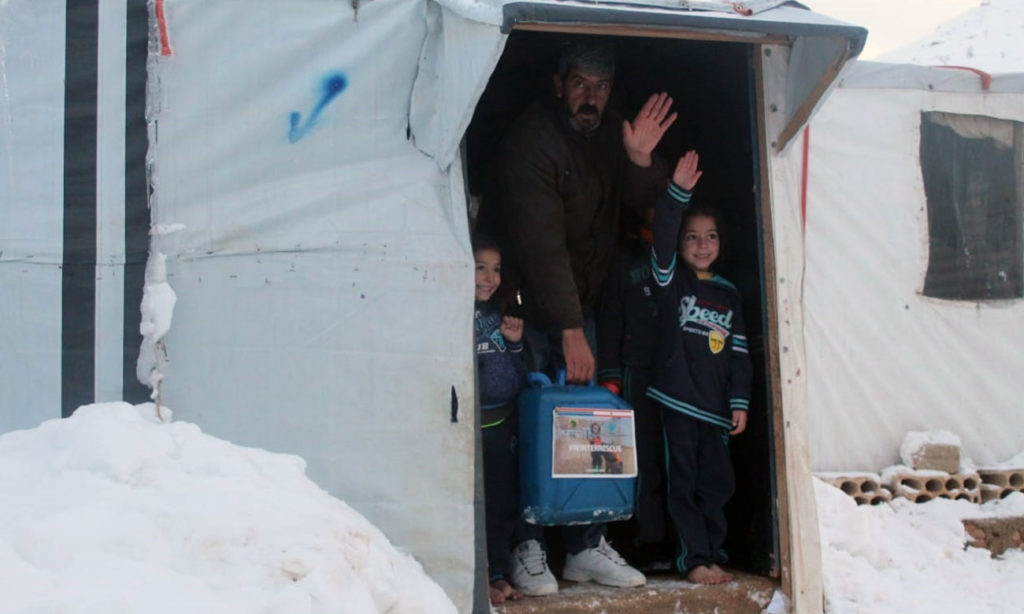
 Distribution of winter aid to Syrian refugees in Aarsal - February 2020 (Union of Relief and Development Associations - URDA)
Distribution of winter aid to Syrian refugees in Aarsal - February 2020 (Union of Relief and Development Associations - URDA)





 A
A
A
A
A
A


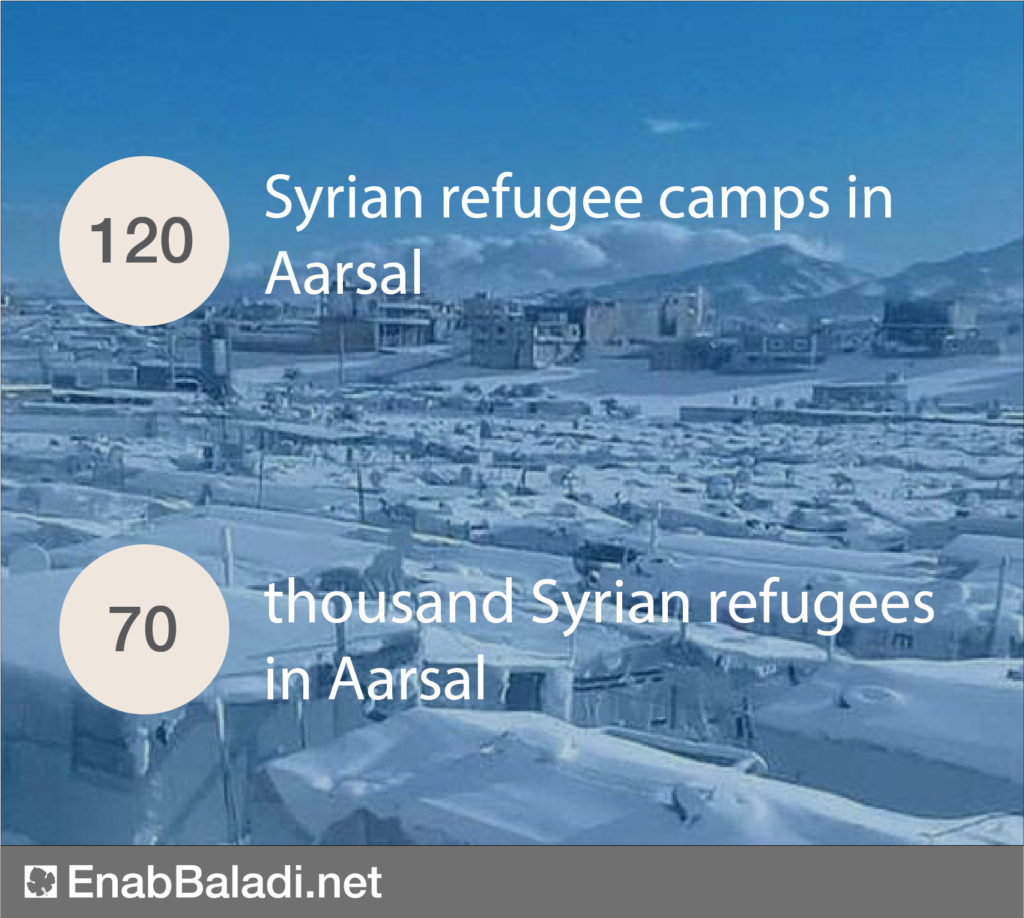
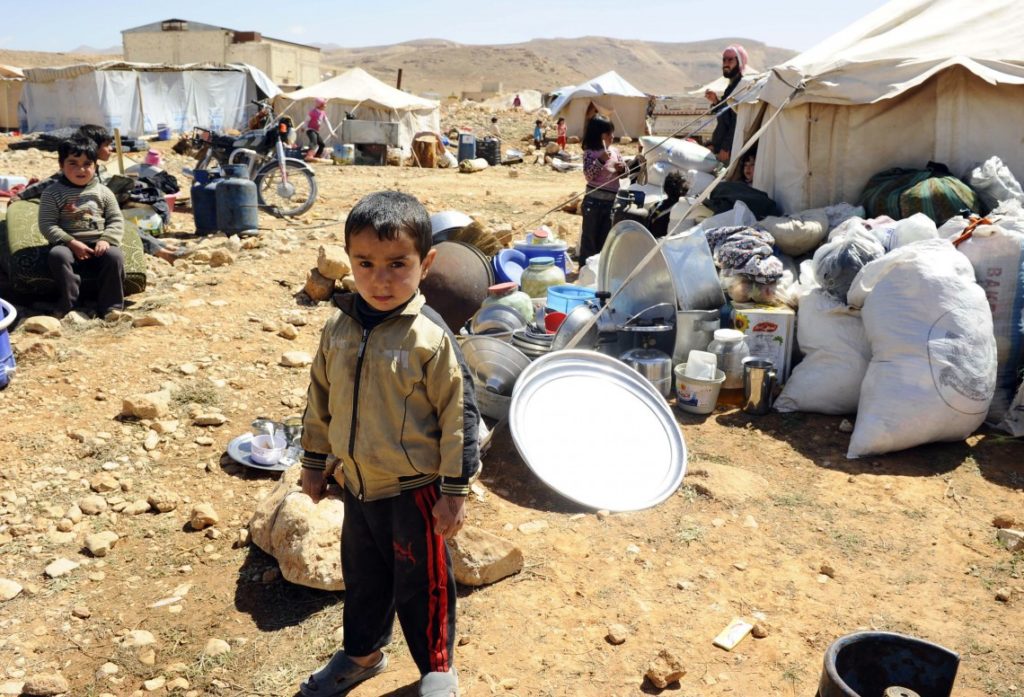
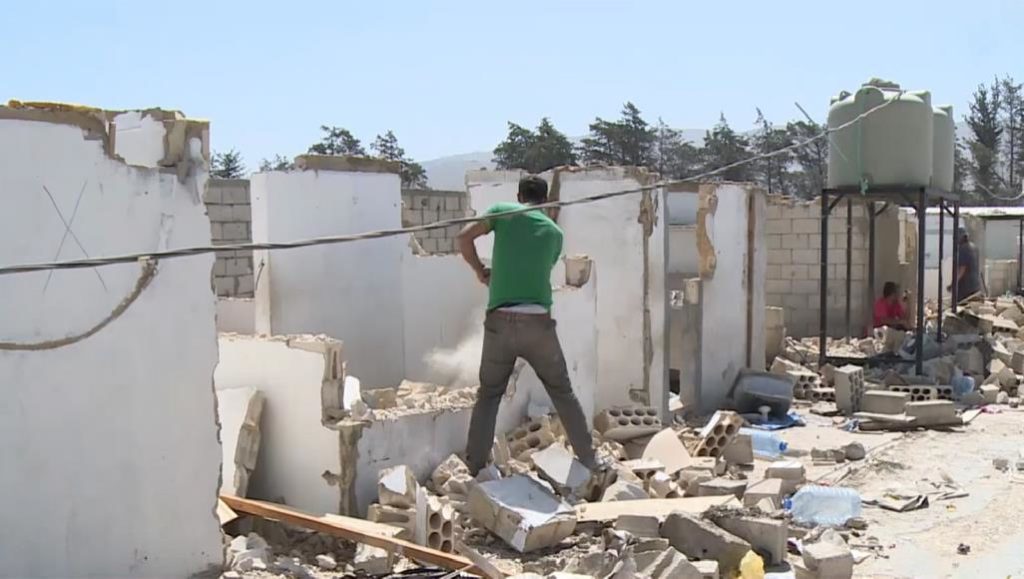
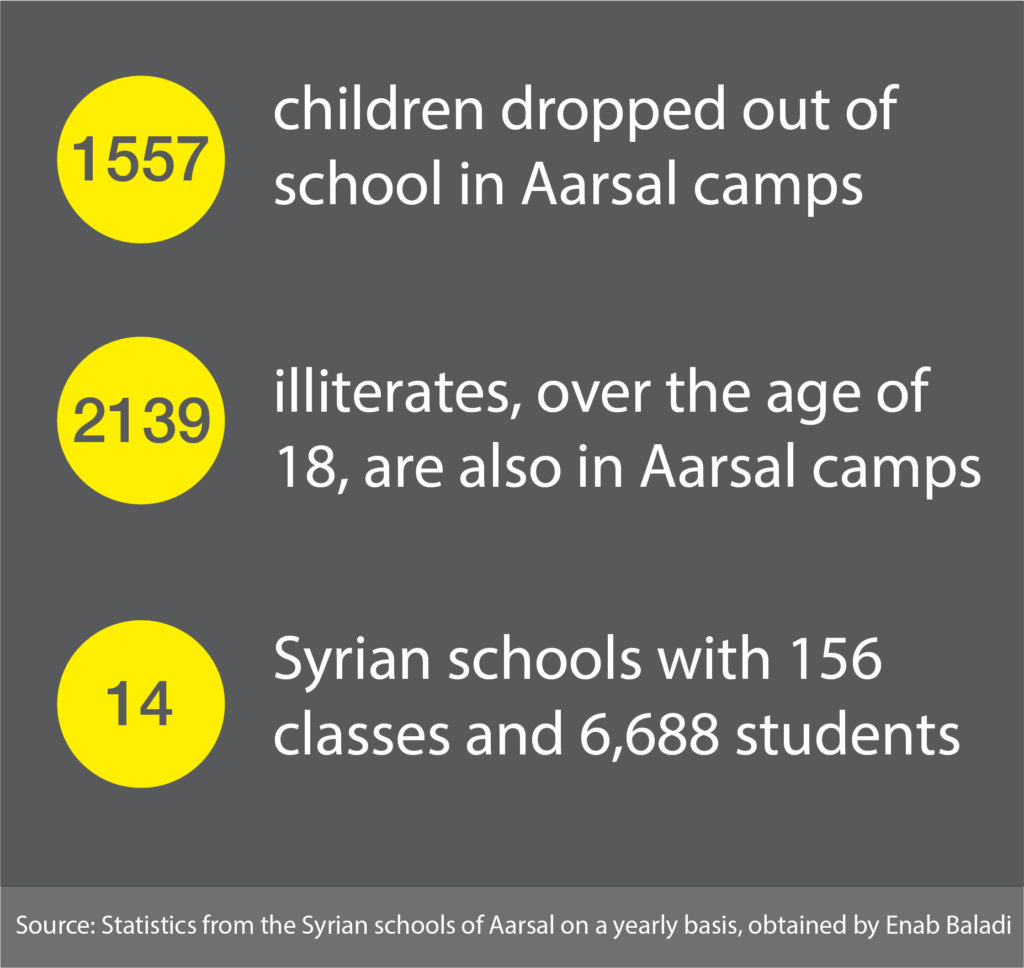



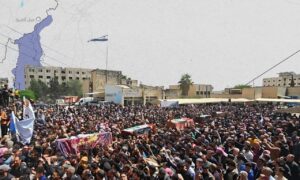



 More In-Depth
More In-Depth